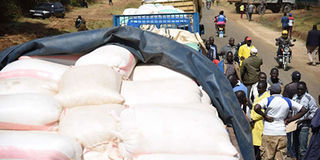Entrenched graft shows State capture a Kenyan phenomenon

Farmers deliver maize to the National Cereals and Produce Board's Eldoret depot on February 5, 2019. Many farmers feel that they get a raw deal from the agency. PHOTO | FILE | NATION MEDIA GROUP
What you need to know:
- State capture is a crude, but often lucrative, form of looting. One uses state institutions and projects for personal benefit.
- The war on corruption may be unearthing more and more skeletons, but the investigative and prosecution capacity must continue to be increased.
State capture is a term frequently applied to the milking and pillaging of state institutions or diversion of state resources for personal and private benefit.
It’s a crude, but often lucrative, form of looting. One uses state institutions and projects for personal benefit.
Kenya has been experiencing that for a long time, and the energy sector is a good example of where it has taken place.
State capture started to take root from 1982 and many government entities had their institutional capacity eroded, run down and even plundered. To this day, it’s very much at play.
For instance, the energy parastatals are almost fully government-owned. Kenya Power is 50.1 per cent State-owned, so the Energy ministry has a big say in its running.
DAMS SCAM
Most senior appointments are made by the relevant lead ministry. The sector has, therefore, become a largely self-serving operation rather than a service-oriented one. As a result, the productivity and efficiency of this sector is way below what it should be.
This is not confined to that sector per se. If we take the operations of the National Cereals and Produce Board, many farmers feel that they get a raw deal from it. The National Irrigation Board is another.
The ongoing dam scams of Arror and Kimwarer, can be viewed in this context. What is notable with these two is that it is The National Treasury which has taken the lead in signing the agreements, committing and parting with large amounts of money in tandem with the Kerio Valley Development Corporation.
Not only are there flashing question marks about the inordinate amounts borrowed and paid upfront, but also whether the relevant ministries were fully consulted. Ultimately, Kenyans will foot the bill.
SHADY PAYMENTS
If Arror is going to produce energy then what consultation, if any, was there with the likes of Kengen and Kenya Power about their share of the costs and transmission modalities? Or will this just turn out to be another burden to the taxpayer?
If Kimwarer is to be an irrigation project, then let us see more of the details. Does it really entail one big dam as opposed to several small ones?
A look at the sequence of events on the dams lifts the lid off why they are a potential mega scam. The two dams are projected to cost in the region of Sh50 billion. The Sh7.5 billion mobilisation fee was paid in full upfront when it should have been in stages.
Then there’s the Sh11 billion so-called insurance cost that was paid. How on earth can the insurance component be some 20 per cent when the standard insurance component is 1-2 per cent?
The burning question is why so much has already been paid out for two projects that are in their very nascent stages and in the opinion of some may not even take off?
GRAFT WAR
A follow-up to this is that a forensic audit should be conducted on the money borrowed and paid out so far and ascertain as to exactly where it went and for what.
Coupled with this, the forensic audit should examine whether there is conflict of interest. For example, were any decision-makers beneficiaries?
The dam scams have got some way to run. Investigations appear to be progressing well and should come to a conclusion sooner rather than later.
What it has shown is that the war on corruption may be unearthing more and more skeletons, but the investigative and prosecution capacity must continue to be increased.
This is so that thorough investigations and prosecutions can be carried out and meaningful convictions can be attained.
The standard-gauge railway saga and the inability to take it to completion has taught us an expensive lesson. Let us learn from this.
LIFESTYLE AUDITS
I suggest that we open a new front in the anti-corruption war. The problem with the much-talked about lifestyle audits is the capacity to carry them out on so many people.
But it can be done on those responsible for these decisions and their relatives and examine any major purchases they undertook.
One of the main reasons Kenya has mixed success in encouraging much more investment and development inflows is because of a wait-and-see approach as to its success in addressing corruption.
Mr Shaw is a public policy and economic analyst. [email protected]




